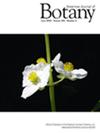Seed dispersal is a critical process impacting individual plants and their communities. Plants have evolved numerous strategies and structures to disperse their seeds, but the evolutionary drivers of this diversity remain poorly understood in most lineages. We tested the hypothesis that the evolution of wind dispersal traits within the melicgrasses (Poaceae: Meliceae Link ex Endl.) was correlated with occupation of open and disturbed habitats.
To evaluate wind dispersal potential, we collected seed dispersal structures (diaspores) from 24 melicgrass species and measured falling velocity and estimated dispersal distances. Species’ affinity for open and disturbed habitats were recorded using georeferenced occurrence records and land cover maps. To test whether habitat preference and dispersal traits were correlated, we used phylogenetically informed multilevel models.
Melicgrasses display several distinct morphologies associated with wind dispersal, suggesting likely convergence. Open habitat taxa had slower-falling diaspores, consistent with increased wind dispersal potential. However, their shorter stature meant that dispersal distances, at a given wind speed, were not higher than those of their forest-occupying relatives. Species with affinities for disturbed sites had slower-falling diaspores and greater wind dispersal distances, largely explained by lighter diaspores.
Our results are consistent with the hypothesized evolutionary relationship between habitat preference and dispersal strategy. However, phylogenetic inertia and other plant functions (e.g., water conservation) likely shaped dispersal trait evolution in melicgrasses. It remains unclear if dispersal trait changes were precipitated by or predated changing habitat preferences. Nevertheless, our study provides promising results and a framework for disentangling dispersal strategy evolution.



